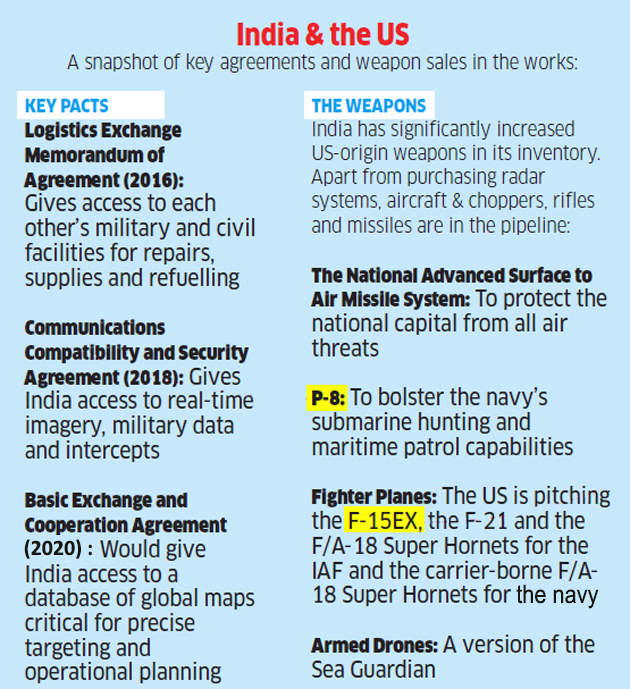International Relations
US’ CAATSA and Russia’s S-400
- 29 Oct 2021
- 7 min read
Why in News
The US lawmakers continue to voice their support for a sanctions waiver from Countering America’s Adversaries Through Sanctions Act (CAATSA) for India.
- In October 2018, India signed a 5.43 billion USD deal with Russia for the S-400 Triumf missile system despite objections from the US and the threat of sanctions under CAATSA. India is likely to begin taking delivery of the S-400 missile defence system from Russia in November 2021.
Key Points
- About the US’ CAATSA:
- US Law: It is a US federal law enacted in 2017. The Act empowers the US President to impose at least five of the 12 listed sanctions on persons engaged in a “significant transaction” with Russian defence and intelligence sectors.
- Its “ultimate goal”, “is to prevent revenue from flowing to the Russian Government.
- Besides Russia, CAATSA is aimed at enforcing sanctions against Iran and North Korea.
- Types of Sanctions: The CAATSA contains 12 types of sanctions. There are only two sanctions that may impact either India-Russia relations or India-US relations.
- Prohibition of Banking transactions: The first of these, which is likely to have an impact on India-Russia relations, is the “Prohibition of Banking transactions”.
- This would mean difficulties for India in making payments in US Dollars to Russia for the purchase of the S-400 systems.
- Export Sanction: The second sanction will have greater consequences for India-US relations.
- This is the “export sanction” which has the potential to completely derail the India-US Strategic and Defence partnership, as it will deny the license for, and export of, any items controlled by the US.
- Prohibition of Banking transactions: The first of these, which is likely to have an impact on India-Russia relations, is the “Prohibition of Banking transactions”.
- Waiver Criteria: The US President was given the authority in 2018 to waive CAATSA sanctions on a case-by-case basis.
- US Law: It is a US federal law enacted in 2017. The Act empowers the US President to impose at least five of the 12 listed sanctions on persons engaged in a “significant transaction” with Russian defence and intelligence sectors.
- Russia’s S-400 Triumf Missile System:
- About:
- It is a mobile, Surface-to-Air Missile system (SAM) designed by Russia.
- It is the most dangerous operationally deployed Modern Long-Range SAM (MLR SAM) in the world, considered much ahead of the US-developed Terminal High Altitude Area Defense system (THAAD).
- It integrates a multifunction radar, autonomous detection and targeting systems, anti-aircraft missile systems, launchers, and command and control centre.
- It is capable of firing three types of missiles to create a layered defence.
- The system can engage all types of aerial targets including aircraft, unmanned aerial vehicles (UAV) and ballistic and cruise missiles within the range of 400km, at an altitude of up to 30km.
- The system can track 100 airborne targets and engage six of them simultaneously.
- Significance for India:
- From India’s point of view, China is also buying the system. In 2015, China signed an agreement with Russia to purchase six battalions of the system. Its delivery began in January 2018.
- China’s acquisition of the S-400 system has been viewed as a “game changer” in the region. However, its effectiveness against India is limited.
- India’s acquisition is crucial to counter attacks in a two-front war, including even high-end F-35 US fighter aircraft.
- From India’s point of view, China is also buying the system. In 2015, China signed an agreement with Russia to purchase six battalions of the system. Its delivery began in January 2018.
- About:
India-US Defence Cooperation
- Both countries signed the ‘New Framework for India-US Defense Relations’ in 2005, which was further updated for 10 years in 2015.
- The USA recognised India as a Major Defence Partner in 2016.
- The designation allows India to buy more advanced and sensitive technologies from America at par with that of the US's closest allies and partners.
- India and US inked important defence pacts in the last few years and also formalised the four nation alliance of QUAD (India, US, Japan and Australia).
- Four Foundational Defence Agreements:
- Basic Exchange and Cooperation Agreement for Geospatial Intelligence (BECA).
- General Security of Military Information Agreement (GSOMIA).
- Logistics Exchange Memorandum of Agreement (LEMOA).
- Communication Compatibility and Security Agreement (COMCASA).
- US Military Equipment in India: Indian Air Force’s C-17 heavy-lifters, Apache attack helicopters and C-130J special operations aircraft, India’s Navy’s P-8I surveillance aircraft and the Indian Army’s M-777 ultra-light howitzers.
- Defence Exercises:
- Malabar exercise (Quadrilateral naval exercise of India, USA, Japan and Australia) , Yudh Abhyas (Army); Cope India (Air Force); Vajra Prahar (Special Forces).
Way Forward
- Russia always saw India as a balancer that's why Russia facilitated India's inclusion into Shanghai Cooperation Organisation (SCO) and formation of Russia-India-China (RIC) grouping.
- India today is in a unique position where it has a favourable relation with all great powers, and she must leverage this position to help in building a peaceful world order.
- The defence procurement for India has become significant amid deadly clashes with China on Line of Actual Control (LAC). Further, Russia is an all weather defence partner of India.
- However, India needs to balance its relation with both Russia and USA, so that its national interest is not compromised.
- It needs to develop closer ties with the United States, which could balance any moves towards a strategic partnership between China and Russia.







